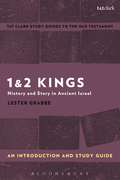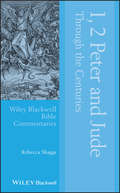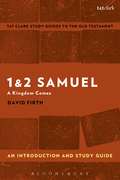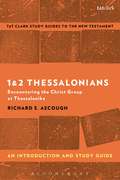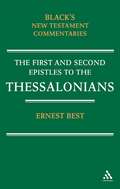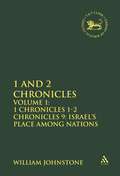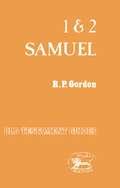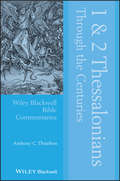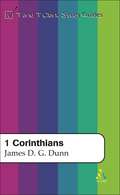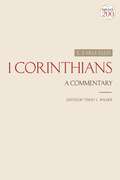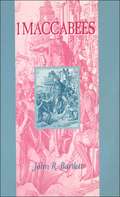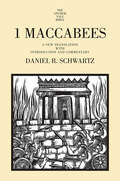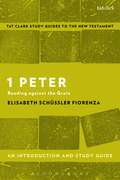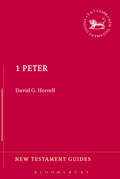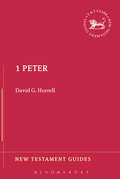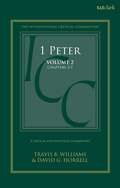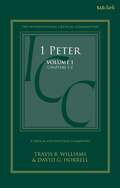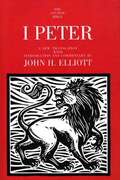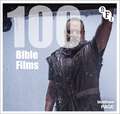- Table View
- List View
1 & 2 Kings: History and Story in Ancient Israel (T&T Clark’s Study Guides to the Old Testament)
by Lester L. GrabbeLester L. Grabbe provides a concise and up-to-date introduction to the books of Kings, covering all the historical and interpretative issues. Grabbe pays particular attention to how the history of ancient Israel can be reconstructed (or not as the case may be) through the text, and introduces students to the key ways of reading the books of Kings as religious and political history.Grabbe takes a chronological approach (according to the text) and provides overviews of the key periods of Israel's history. The nature of the 'Deuteronomistic History' and how well this theory of authorship stands up in the modern day is considered, as well as issues of form and source criticism more broadly. Grabbe concludes by offering a reflection on the books of Kings in theological and hermeneutical perspective, which enables students to view not only the historical and textual issues, but also broader issues of meaning and significance.
1, 2 Peter and Jude Through the Centuries (Wiley Blackwell Bible Commentaries)
by Rebecca SkaggsExplores the epistles’ reception history and their effects in sermons, music, art, literature, and politics over time 1, 2 Peter and Jude Through the Centuries considers three small epistles which are often overlooked in controversial discussions of theology, culture, art, music, politics, and literature. This book offers fresh perspectives on the epistles’ effects in numerous theological and cultural contexts such as slavery, the role of women in marriage, the nature of Christology, and how believers should relate to the government. Author Rebecca Skaggs traces the reception history of 1 Peter, Jude, and 2 Peter and investigates the texts’ effects on diverse doctrinal, social and political issues. Their influence on artists, musicians, dramatists and literary writers is explored, especially the Doctrine of the Descent of Christ into Hades. Each chapter includes an overview of central issues and topics, a selection of ancient readings with interpretations and a brief survey of modern scholarship on the subject. Illuminating how readings vary across historical periods and interpretive communities, this book: Traces the multi-faceted contributions of 1 and 2 Peter and Jude to theological discussions Provides a sampling of the kinds of effects available from each of the texts in various contexts Shows how the epistles engage in the discussions and controversies of the Medieval Ages Offers discussions of the epistles’ contributions to doctrinal debates on the inspiration of scripture and how to respond to heresy in the church Features detailed treatment of topics such as Christ’s visit to the spirits in prison, the dispute between Michael and Satan over Moses’ body and the final judgment by fire Features commentary from a leading scholar in New Testament Studies and Christian Theology Offering enlightening essays and new approaches, 1, 2 Peter and Jude Through the Centuries is an ideal book for anyone interested in the rich contributions of these epistles, such as Biblical and Theological Studies students, and pastors looking for original insights on reception material.
1, 2 Peter and Jude Through the Centuries (Wiley Blackwell Bible Commentaries)
by Rebecca SkaggsExplores the epistles’ reception history and their effects in sermons, music, art, literature, and politics over time 1, 2 Peter and Jude Through the Centuries considers three small epistles which are often overlooked in controversial discussions of theology, culture, art, music, politics, and literature. This book offers fresh perspectives on the epistles’ effects in numerous theological and cultural contexts such as slavery, the role of women in marriage, the nature of Christology, and how believers should relate to the government. Author Rebecca Skaggs traces the reception history of 1 Peter, Jude, and 2 Peter and investigates the texts’ effects on diverse doctrinal, social and political issues. Their influence on artists, musicians, dramatists and literary writers is explored, especially the Doctrine of the Descent of Christ into Hades. Each chapter includes an overview of central issues and topics, a selection of ancient readings with interpretations and a brief survey of modern scholarship on the subject. Illuminating how readings vary across historical periods and interpretive communities, this book: Traces the multi-faceted contributions of 1 and 2 Peter and Jude to theological discussions Provides a sampling of the kinds of effects available from each of the texts in various contexts Shows how the epistles engage in the discussions and controversies of the Medieval Ages Offers discussions of the epistles’ contributions to doctrinal debates on the inspiration of scripture and how to respond to heresy in the church Features detailed treatment of topics such as Christ’s visit to the spirits in prison, the dispute between Michael and Satan over Moses’ body and the final judgment by fire Features commentary from a leading scholar in New Testament Studies and Christian Theology Offering enlightening essays and new approaches, 1, 2 Peter and Jude Through the Centuries is an ideal book for anyone interested in the rich contributions of these epistles, such as Biblical and Theological Studies students, and pastors looking for original insights on reception material.
1 & 2 Samuel: A Kingdom Comes (T&T Clark’s Study Guides to the Old Testament)
by David FirthScholarly study of Samuel continues to wrestle with how we interpret this pivotal text. Even such basic matters as the question of what kind of literature it is remain unresolved while older questions such as the nature of its text and sources are debated anew in the light of material from Qumran and of current approaches to Hebrew narrative. Recognizing the importance of questions such as these, David Firth explores and introduces fresh ways of reading Samuel as a unified and yet complex text, which displays high levels both of literary artistry and of theological commitment.Although some stories in the books of Samuel are well known, and in the case of David and Goliath even proverbial, much of the content of these books is strange to modern readers. It is a story about a woman wanting a child, for example, that relates the beginnings of monarchy within Israel. Even the question of the monarchy is problematic, for we are introduced to not one royal family but two-those of Saul and David. David is ultimately shown to be the king chosen by God, yet by the end of the book he is only just managing to hold on to the kingdom as it is nearly torn from him by rivalries within his family. These arresting stories are perplexing, for Samuel's writers seldom tell us how to read and interpret them. Firth presents these complex and fascinating stories as part of a bigger picture, enabling students to chart their way through the literary and historical issues of the Samuel narrative. Firth addresses issues of historicity, sources, date and authorship, as well as -- crucially -- appreciating the text as a literary whole.
1 & 2 Samuel: A Kingdom Comes (T&T Clark’s Study Guides to the Old Testament)
by David FirthScholarly study of Samuel continues to wrestle with how we interpret this pivotal text. Even such basic matters as the question of what kind of literature it is remain unresolved while older questions such as the nature of its text and sources are debated anew in the light of material from Qumran and of current approaches to Hebrew narrative. Recognizing the importance of questions such as these, David Firth explores and introduces fresh ways of reading Samuel as a unified and yet complex text, which displays high levels both of literary artistry and of theological commitment.Although some stories in the books of Samuel are well known, and in the case of David and Goliath even proverbial, much of the content of these books is strange to modern readers. It is a story about a woman wanting a child, for example, that relates the beginnings of monarchy within Israel. Even the question of the monarchy is problematic, for we are introduced to not one royal family but two-those of Saul and David. David is ultimately shown to be the king chosen by God, yet by the end of the book he is only just managing to hold on to the kingdom as it is nearly torn from him by rivalries within his family. These arresting stories are perplexing, for Samuel's writers seldom tell us how to read and interpret them. Firth presents these complex and fascinating stories as part of a bigger picture, enabling students to chart their way through the literary and historical issues of the Samuel narrative. Firth addresses issues of historicity, sources, date and authorship, as well as -- crucially -- appreciating the text as a literary whole.
1 & 2 Thessalonians: Encountering the Christ Group at Thessalonike (T&T Clark’s Study Guides to the New Testament)
by Richard S. Ascough1 Thessalonians provides a fascinating glimpse into the origins and social life of the Christ group in the ancient Roman city of Thessalonike, while 2 Thessalonians reveals how the community developed at a somewhat later time. This guide narrates the story of the founding of the group by considering the social and cultural contexts, the literary form, the rhetorical strategies, the theologies, and the reception of the two canonical letters. While centering on the texts of 1 and 2 Thessalonians themselves, Ascough draws widely on literary and archaeological data, giving particular attention to typical group behaviours among small, unofficial associations in the Greek and Roman period. The first four chapters focus on 1 Thessalonians, from the initial formation of the Christ group out of a small association of artisans through to how members negotiated various sorts of relationships: with Paul and his companions, with outsiders in Thessalonike and beyond, and especially with fellow believers within the group itself. The final two chapters turn attention to the shifting circumstances that required a second letter to be written, with its focus on disorder and disruption of social practices and theological beliefs. The epilogue briefly surveys Christianity at Thessalonike beyond the 1st century. This guide presents an overview of the historical development of the Christ group at Thessalonike. Moving beyond treating the canonical letters as simple repositories of theological opinions, Ascough demonstrates how 1 and 2 Thessalonians reveal ordinary life in ancient Roman cities. In so doing, he invites readers to enter the world of one of the many fascinating communities of Christ believers in the 1st century of the Common Era.
1 & 2 Thessalonians: Encountering the Christ Group at Thessalonike (T&T Clark’s Study Guides to the New Testament)
by Richard S. Ascough1 Thessalonians provides a fascinating glimpse into the origins and social life of the Christ group in the ancient Roman city of Thessalonike, while 2 Thessalonians reveals how the community developed at a somewhat later time. This guide narrates the story of the founding of the group by considering the social and cultural contexts, the literary form, the rhetorical strategies, the theologies, and the reception of the two canonical letters. While centering on the texts of 1 and 2 Thessalonians themselves, Ascough draws widely on literary and archaeological data, giving particular attention to typical group behaviours among small, unofficial associations in the Greek and Roman period. The first four chapters focus on 1 Thessalonians, from the initial formation of the Christ group out of a small association of artisans through to how members negotiated various sorts of relationships: with Paul and his companions, with outsiders in Thessalonike and beyond, and especially with fellow believers within the group itself. The final two chapters turn attention to the shifting circumstances that required a second letter to be written, with its focus on disorder and disruption of social practices and theological beliefs. The epilogue briefly surveys Christianity at Thessalonike beyond the 1st century. This guide presents an overview of the historical development of the Christ group at Thessalonike. Moving beyond treating the canonical letters as simple repositories of theological opinions, Ascough demonstrates how 1 and 2 Thessalonians reveal ordinary life in ancient Roman cities. In so doing, he invites readers to enter the world of one of the many fascinating communities of Christ believers in the 1st century of the Common Era.
1 & 2 Thessalonians: 1 And 2 Thessalonians (Black's New Testament Commentaries)
by Ernest BestThe 1974 estimate by Interpretation that Ernest Best's volume on 1 & 2 Thessalonians "is probably the best exegetical study of 1 and 2 Thessalonians available … a superb commentary†? continues to ring true forty years later. This is indeed one of the finest commentaries on 1 & 2 Thessalonians available-in any language. The Journal of Theological Studies called it "exhaustive†? and concluded that the commentary is "reliable, judicious, and nearly always lucid. He [Best] … takes us as far as we can reasonably go in understanding the mind of Paul as it expressed itself in these writings.†?
1 and 2 Chronicles: Volume 2: 2 Chronicles 10-36: Guilt and Atonement (The Library of Hebrew Bible/Old Testament Studies)
by William JohnstoneThis two-part commentary argues that Chronicles, placed as it is among the 'historical books' in the traditional Old Testament of the Christian church, is much misunderstood. Restored to its proper position as the final book in the canon as arranged in the order of the Hebrew Bible, it is rather to be understood as a work of theology essentially directed towards the future. The Chronicler begins his work with the problem facing the whole human race in Adam-the forfeiture of the ideal of perfect oneness with God's purpose. He explores the possibility of the restoration of that ideal through Israel's place at the centre of the world of the nations. This portrayal reaches its climax in an idealized presentation of the reign of Solomon, in which all the rulers of the earth, including most famously the Queen of Sheba, bring their tribute in acknowledgment of Israel's status (Volume 1). As subsequent history only too clearly shows, however, the Chronicler argues (Volume 2), that Israel itself, through unfaithfulness to Torah, has forfeited its right to possession of its land and is cast adrift among these same nations of the world. But the Chronicler's message is one of hope. By a radical transformation of the chronology of Israel's past into theological terms, the generation whom the Chronicler addresses becomes the fiftieth since Adam. It is the generation to whom the jubilee of return to the land through a perfectly enabled obedience to Torah, and thus the restoration of the primal ideal of the human race, is announced.
1 and 2 Chronicles: Volume 1: 1 Chronicles 1-2 Chronicles 9: Israel's Place among Nations (The Library of Hebrew Bible/Old Testament Studies)
by William JohnstoneThis two-part commentary argues that Chronicles, placed as it is among the 'historical books' in the traditional Old Testament of the Christian church, is much misunderstood. Restored to its proper position as the final book in the canon as arranged in the order of the Hebrew Bible, it is rather to be understood as a work of theology essentially directed towards the future. The Chronicler begins his work with the problem facing the whole human race in Adam-the forfeiture of the ideal of perfect oneness with God's purpose. He explores the possibility of the restoration of that ideal through Israel's place at the centre of the world of the nations. This portrayal reaches its climax in an idealized presentation of the reign of Solomon, in which all the rulers of the earth, including most famously the Queen of Sheba, bring their tribute in acknowledgment of Israel's status (Volume 1). As subsequent history only too clearly shows, however, the Chronicler argues (Volume 2), that Israel itself, through unfaithfulness to Torah, has forfeited its right to possession of its land and is cast adrift among these same nations of the world. But the Chronicler's message is one of hope. By a radical transformation of the chronology of Israel's past into theological terms, the generation whom the Chronicler addresses becomes the fiftieth since Adam. It is the generation to whom the jubilee of return to the land through a perfectly enabled obedience to Torah, and thus the restoration of the primal ideal of the human race, is announced.
1 and 2 Samuel (Old Testament Guides)
by Robert P. GordonA comprehensive introduction to the critical issues raised by scholarship on both books of Samuel. The often intricate problems are dealt with clearly and engagingly; the chapters deal with the Deuteronomistic History, the Shiloh tradition, the Ark narrative, the rise of the monarchy, the reign of Saul, the story of David, the Davidic covenant, the Succession Narrative and the Samuel appendix. A first-rate guide for students, with annotated bibliographies and indexes.
1 and 2 Thessalonians Through the Centuries (Wiley Blackwell Bible Commentaries)
by Anthony C. ThiseltonThis unique commentary on Paul’s early letters by an outstanding New Testament specialist, provides a broad range of original perspectives of how people have interpreted, and been influenced by, Paul’s first two letters. Addresses questions concerning the content, setting, and authenticity of the two Thessalonian letters, drawing on responses from leading scholars, poets, hymn writers, preachers, theologians, and biblical scholars throughout the ages Offers new insights into issues they raise concerning feminist biblical interpretation. Provides a history of two-way influences, as exemplified by Ulrich Luz, Hans Robert Jauss, and Hans-Georg Gadamer Written by Anthony Thiselton, a leading commentator on the Greek New Testament
1 and 2 Thessalonians Through the Centuries (Wiley Blackwell Bible Commentaries #28)
by Anthony C. ThiseltonThis unique commentary on Paul’s early letters by an outstanding New Testament specialist, provides a broad range of original perspectives of how people have interpreted, and been influenced by, Paul’s first two letters. Addresses questions concerning the content, setting, and authenticity of the two Thessalonian letters, drawing on responses from leading scholars, poets, hymn writers, preachers, theologians, and biblical scholars throughout the ages Offers new insights into issues they raise concerning feminist biblical interpretation. Provides a history of two-way influences, as exemplified by Ulrich Luz, Hans Robert Jauss, and Hans-Georg Gadamer Written by Anthony Thiselton, a leading commentator on the Greek New Testament
1 Corinthians (New Testament Guides)
by James D. DunnConcise yet comprehensive, manageable and affordable, T&T Clark Study Guides are an invaluable resource for students, preachers and Bible study leaders. Each book in the series gives the reader a thorough introduction to a particular book of the Bible or the Apocrypha and includes:• An introduction to the contents of the particular biblical book• A balanced survey of the important critical issues• Attention to literary, historical, sociological, and theological perspectives• Suggestions about critical appropriation of the text by the contemporary reader• Reference to other standard works through annotated bibliographies.All the books in the series, formerly published by Sheffield Academic Press, are by leading biblical scholars and the authors have drawn on their scholarly expertise as well as their experience as teachers of university and college students.
1 Corinthians: A Commentary
by E. Earle EllisThis volume presents, in published form, the detailed commentary work of E. Earle Ellis on Paul's first letter to the Corinthians. At the time of his death Ellis had been working for many years on a volume for the International Critical Commentary on the epistle. Because Ellis was unable to complete the volume before his passing and had left instructions that it should not be completed, Terry Wilder instead presents Ellis' profound exegetical insights in the form of his completed commentary sections on 1 Corinthians, with minimal editorial intervention.In addition to collating Ellis' detailed critical commentary on 1 Corinthians chapters 1-13, with edited notes on chapter 14, Wilder has also completed an original editorial essay that provides a synthesis of Ellis' notes and thinking on chapters 15 and 16. Closely assessing the letter's address, salutation and thanksgiving and Paul's words on true and false wisdom, sexual relationships, liberty's boundaries and the regulation of church services, Ellis' final work is a crucial resource for a core New Testament text.
1 Maccabees (Guides to the Apocrypha and Pseudepigrapha)
by John R. BartlettThis is a book for anyone interested in the political and cultural results of the entry of the small state of Judah and its capital Jerusalem into the wider Hellenistic world in the second century BCE. In particular it forms a helpful introduction to the biblical writing called 1 Maccabees, which is preserved in the Apocrypha. 1 Maccabees is a history of the rebellion of the Jews against their Syrian rulers in the 160s BCE. The rebellion's leader was Judas Maccabee, and from his family and its success sprang a dynasty that ruled Judah for the century before the arrival of Herod the Great. The author of 1 Maccabees was a keen supporter of that dynasty, and saw their early rulers as made in the mould of the early kings of Israel. The present book introduces the student to modern scholarly research on 1 Maccabees and its author.
1 Maccabees: A New Translation with Introduction and Commentary (The Anchor Yale Bible Commentaries)
by Daniel R. SchwartzA new translation and commentary on I Maccabees that offers a fresh interpretation of the author’s values and purpose First Maccabees, composed in the second century BCE, chronicles four decades of clashes between Hellenistic Syria and Judea, from Antiochus Epiphanes’s ascent to the throne in 175 BCE to the Hasmoneans’ establishment of an independent Judean state, ruled by Simon and his sons. In this volume, Daniel R. Schwartz provides a new translation of the Greek text and analyzes its historical significance. In dialogue with contemporary scholarship, the introduction surveys the work’s themes, sources, and transmission, while the commentary addresses textual details and issues of historical reconstruction, often devoting special attention to the lost Hebrew original and its associations. Schwartz demonstrates that 1 Maccabees, despite its Hebraic biblical style and its survival within the Christian canon, deviates from biblical and Judaic works by marginalizing God, evincing scorn for martyrs, and ascribing to human power and valor crucial historical roles. This all fits its mandate: justification of the Hasmonean dynasty, especially the Simonides.
1 Peter: Reading against the Grain (T&T Clark’s Study Guides to the New Testament)
by Elisabeth Schüssler FiorenzaThe New Testament writing known as First Peter was probably written at the end of the 1st century CE; it is addressed to 'resident aliens' who live as colonial subjects in the Roman Province of Asia Minor. They are portrayed as a marginalized group who experience harassment and suffering. This letter is ascribed to the apostle Peter but was probably not written by him. It is a rhetorical communication sent from Christians in the imperial centre in Rome (camouflaged as Babylon), an authoritative letter of advice and admonition to good conduct and subordination in the sphere of colonial provincial life. 1 Peter is a religious document written a long time ago and in a culture and world that is quite different from our own. However, as a biblical book it is a part of Christianity's sacred Scriptures. This guide to the letter keeps both of these areas, the cultural-social and the ethical-religious, in mind. It offers help for understanding the letter as both a document of the 1st century and as sacred Scripture that speaks about the religious forces that have shaped Christianity and Western culture. In short, this guide seeks to enable readers to read 'against the grain'.
1 Peter: Reading against the Grain (T&T Clark’s Study Guides to the New Testament)
by Elisabeth Schüssler FiorenzaThe New Testament writing known as First Peter was probably written at the end of the 1st century CE; it is addressed to 'resident aliens' who live as colonial subjects in the Roman Province of Asia Minor. They are portrayed as a marginalized group who experience harassment and suffering. This letter is ascribed to the apostle Peter but was probably not written by him. It is a rhetorical communication sent from Christians in the imperial centre in Rome (camouflaged as Babylon), an authoritative letter of advice and admonition to good conduct and subordination in the sphere of colonial provincial life. 1 Peter is a religious document written a long time ago and in a culture and world that is quite different from our own. However, as a biblical book it is a part of Christianity's sacred Scriptures. This guide to the letter keeps both of these areas, the cultural-social and the ethical-religious, in mind. It offers help for understanding the letter as both a document of the 1st century and as sacred Scripture that speaks about the religious forces that have shaped Christianity and Western culture. In short, this guide seeks to enable readers to read 'against the grain'.
1 Peter (New Testament Guides)
by David G. HorrellThis volume offers a concise and accessible introduction to 1 Peter, especially aimed at undergraduate-level students. It provides information on the likely historical and social setting of this letter, on its literary form and theological content, and on issues involved in its interpretation. In particular, this volume suggests that 1 Peter is an important text not least for the ways in which it both reflects and constructs early Christian identity, in its relationships with Judaism and the Roman Empire. Although 1 Peter remains neglected compared with the canonical gospels and the major Pauline letters, Horrell argues that the letter deserves much more attention for the pivotal contribution it makes to the development of early Christianity and for the ways in which it reveals this development in progress.
1 Peter: Essays On 1 Peter And The Making Of Christian Identity (New Testament Guides)
by David G. HorrellThis volume offers a concise and accessible introduction to 1 Peter, especially aimed at undergraduate-level students. It provides information on the likely historical and social setting of this letter, on its literary form and theological content, and on issues involved in its interpretation. In particular, this volume suggests that 1 Peter is an important text not least for the ways in which it both reflects and constructs early Christian identity, in its relationships with Judaism and the Roman Empire. Although 1 Peter remains neglected compared with the canonical gospels and the major Pauline letters, Horrell argues that the letter deserves much more attention for the pivotal contribution it makes to the development of early Christianity and for the ways in which it reveals this development in progress.
1 Peter: A Critical and Exegetical Commentary: Volume 2: Chapters 3-5 (International Critical Commentary)
by David G. Horrell Travis B. WilliamsThe second volume in Travis B. Williams' and David G. Horrell's magisterial ICC commentary on first Peter. Williams and Horrell bring together all the relevant aids to exegesis - linguistic, textual, archaeological, historical, literary, and theological - to help the reader understand the letter. This second covers the major part of the letter, providing commentary on 2.11 to the end of the letter. The exegesis provides for each passage sections on bibliography, text-criticism, literary introduction, detailed exegesis, and overall summary. The volume concludes with a comprehensive bibliography, which covers the whole epistle.
1 Peter: A Critical and Exegetical Commentary: Volume 1: Chapters 1-2 (International Critical Commentary)
by David G. Horrell Travis B. WilliamsThe first volume in Travis B. Williams' and David G. Horrell's magisterial ICC commentary on first Peter. Williams and Horrell bring together all the relevant aids to exegesis - linguistic, textual, archaeological, historical, literary, and theological - to help the reader understand the letter. This first volume presents introductory maps, and a comprehensive introduction covering aspects such as genre, canonicity, early citations of the letter, and its theology and influence. A particular feature of the introduction is that each section is preceded by an initial bibliography. The exegesis also provides for each passage sections on bibliography, text-criticism, literary introduction, detailed exegesis, and overall summary. Following the introduction volume 1 provides commentary up to 2.10, the conclusion of the first major section of the letter.
1 Peter (Anchor Bible): (pdf)
by John H. ElliottThe significance of the First Letter of Peter for the formation of Christianity stands in sharp contrast to its brevity. John H. Elliott, a leading authority on this letter, brings its significance to life in this magnificent addition to the renowned Anchor Bible Commentaries. Elliott sets the book into context, covering its literary, historical, theological, and linguistic elements. In detailed, accessible discussions, he draws on the latest research to illuminate the social and cultural influences on the Church in its initial years. Treating such important Petrine concerns as living honorably in a hostile society, finding meaning in suffering, and resisting social assimilation as the elect and holy family of God, the translation, notes, and commentary in this volume will help readers appreciate the powerful and enduring message of this fascinating letter.
100 Bible Films (BFI Screen Guides)
by Matthew PageFrom The Passion of the Christ to Life of Brian, and from The Ten Commandments to Last Temptation of Christ, filmmakers have been adapting the stories of the Bible for over 120 years, from first time the Höritz Passion Play was filmed in the Czech Republic back in 1897. Ever since, these stories have inspired musicals, comedies, sci-fi, surrealist visions and the avant garde not to mention spawning their own genre, the biblical epic. Filmmakers across six continents and from all kinds of religious perspectives (or none at all), have adapted the greatest stories ever told, delighting some and infuriating others.100 Bible Films is the indispensible guide to this wide and varied output, providing an authoritative but accessible history of biblical adaptations through one hundred of the most interesting and significant biblical films. Richly illustrated with film stills, this book depicts how such films have undertaken a complex negotiation between art, commerce, entertainment and religion.Matthew Page traces the screen history of the biblical stories from the very earliest silent passion plays, via the golden ages of the biblical epic, through to more innovative and controversial later films as well as covering significant TV adaptations. He discusses films made not only by some of our greatest filmmakers, artists such as Martin Scorsese, Jean Luc Godard, Alice Guy, Roberto Rossellini, Pier Paolo Pasolini, Lotte Reiniger, Carl Dreyer and Luis Buñuel, but also those looking to explore their faith or share it with lovers of cinema the world over.
